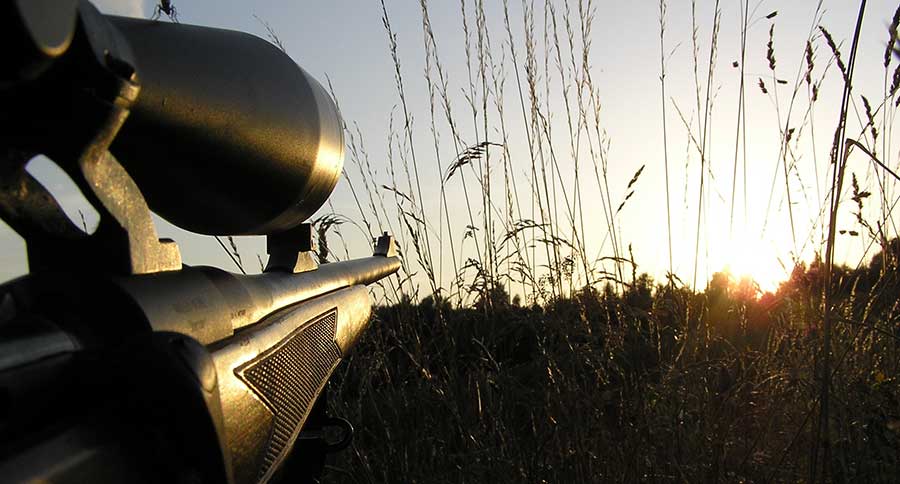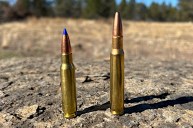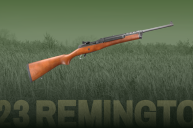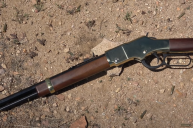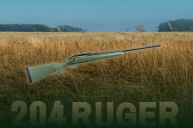Here's everything you need to know about gun performance specifications, explained in a way you can understand.
By Josh Wayner via The Truth About Guns
Josh Wayner's taken it upon himself to challenge what everyone "knows" as far as barrel length, velocity and accuracy are concerned. According to his results, the conventional wisdom ain't all that wise when it comes to longer-barreled ballistics. The only question then is, if you buy in and go with a short barrel, can you stand the noise?
SEE ALSO: The Joy of a Custom Gun Build
Abstract: This is an independent scientific study that has been conducted in western Michigan. This study addresses the misunderstanding of the concepts related to barrel length, muzzle velocity, and accuracy in a rifle . . .
Elements of the Study: This study was conducted with a set of standards that do not necessarily correspond to all manner of firearms. The combination of weapon and ammunition used for this study was carefully determined and analyzed for the best results. This study was conducted with what the author and fellow researchers determined to be the most precise materials and methods available gathered from expert input and other existing studies.
The platform used for this is a Shilen match barrel which began at 26 inches in length and ended at 13.5 inches. The chamber is of standard SAAMI specification in 308 Winchester and the barrel features a 1:10 right hand twist. The ammunition used for this test is of several types, all of which are of corresponding lot numbers. At each range, handloads were used to seek out advantages given the barrel length by modifying the bullet and powder. This data is included gratis and represents the abilities of the weapon system when tuned ammunition is available.
For this test, the barrel was attached to a Savage short action target receiver in a Scally Hill Systems MK4 Mod7 folding chassis. This test measured all three variables at the same time in the most similar conditions available. Testing was conducted at Southkent Sportsman's Club in Dorr, Michigan andChick-Owa Sportsman's Club in Zeeland, Michigan. Firing was conducted at a distance minimum of 100 yards and a maximum of 540 yards. Informal 'field' shooting was conducted on private land at safe targets out to a distance of 900 yards, accurately measured by satellite using Google Earth.
Ambient conditions were on average 70-75 degrees Fahrenheit with 40-50% humidity at an elevation average of 670 feet. Shooting was conducted with a 16x SWFA SS optic, a piece well noted for its durability and ruggedness. Velocities were obtained using a chronograph and extrapolation of shooting results. Group size was measured with a micrometer. Five shot groups were used to measure accuracy. Firing was conducted on standard IPSC silhouette targets at all ranges.
This study does not aim to look at terminal effects, rates of drop and drift, combat effectiveness, ethical viewpoints, or legal/political issues.
Findings
This section is included here as a semi-abstract to address commonly held beliefs regarding barrel length, muzzle velocity, and accuracy. These results are backed by the data collected below.
Explaining Barrel Length
Belief: a long barrel is required for accuracy when shooting at long distance.
Fact: In no part of our testing was barrel length a determining factor in accuracy. At a distance of 100-540 yards, there was no discernible difference in accuracy between various barrel lengths. This performance translated over to unknown distance shooting with all barrel lengths at ranges out to 900 yards. At no point in the testing was a short barrel a hindrance once marksmanship fundamentals were observed and proper flight data was applied.
SEE MORE: "Guns Don't Need to Be Loud": SilencerCo CEO Talks About $130 Gun Trust
Explaining Velocity
Belief: Now that we know that accuracy is pretty much the same, short barreled rifles lose too much velocity be effective at long ranges.
Fact: This is a double-edged sword. The 13.5-inch length could propel a 168 grain Hornady TAP round at an average velocity of 2390 fps, which is hardly slow. That is only a decrease of around 315 fps from the 26 inch length (25.2 fps/in), and vindicates many researchers who pioneered velocity discussions. There was no noticeable critical difference in accuracy at any range. There is a downside to longer ranges and reduced velocities, that being increased susceptibility to wind as range increases. Increased drift is not the end of the world, though, and if measured properly, can be overcome with ease.
What is more is the differences in velocity across loads and barrel lengths. The issue with barrel length and velocity was also interesting in that, across all bullet weights, the extreme variation is only 31% (110 VMAX @3202 and 208 AMAX @2215). In the most accurate load, the 168gr HPBT handload, the velocity difference between longest and shortest was only slightly more than 15%. The round with the least variation between barrel lengths was the 175gr Federal Gold Medal Match with slightly less than 8% variation.
Explaining Accuracy in a Practical Sense
Belief: "The time I put five shots into a cloverleaf is the time I did everything right."
Fact: This is the greatest misunderstanding in the world of accuracy and shooting. In our testing, no matter the ammunition used, the weapon showed that there was a natural fluctuation in regard to group size and point of impact. This has been determined by other studies as well, even those using 'rail guns' and heavy benchrest rifles. Accuracy, at least in our testing, was determined to be more akin to a 'cone' than a grid in that the accuracy of the rifle had an average maximum radial spread of .765 MOA over all barrel lengths.
In layman's terms, this means that the barrel could fire an indefinite number of rounds into a circle with an average diameter of 1.53 MOA, which is not all that impressive. However, it must be understood that accuracy does not work like traditional manuals dictate. As an example, a man takes his new rifle to the range. He sets up his targets and fires several five shot groups. His groups are respectable by most standards, with most clustering at around .75 MOA. He sets his zero and continues to fire.
Here is the important part: he fires another group and gets a 'flier' one MOA low and left. He discards it and continues, discarding all the fliers he gets. Now it gets hard for him to figure out. He shoots five shots and notices that he gets a .25 MOA group, but .8 MOA low and .45 MOA right. This is a great group, and he scratches his head and adjusts his scope to it. He shoots again, but prints a wide group measuring 1.2 MOA across, but now shifted off his zero. He assumes that he has run his luck out, packs up, and goes home.
What has happened here has happened to many people. What our friend did not realize was that his gun was never zeroed at all. The tight cluster he got was not the time he did it right, it was a statistical possibility that comes from firing. In reality, the man had a rifle that was not shooting .75 MOA, but rather he was printing groups and ignoring his most important ally, his fliers. These are critical to rifle accuracy and are not mistakes.
Statistically speaking, the rifle he has may actually fire a maximum group size of 2 MOA at 100 yards, which sounds terrible, but really isn't. The vast majority of his rounds will probably impact at a radius of around .5 MOA of his true zero, or even less if he has a good combination. What he did not understand was that there is nothing wrong with a rifle that may throw a round out even 1 MOA or more, it's all within the statistical level of accuracy that the rifle is capable of.
SEE MORE: 8 of the Weirdest Custom Conversions of Common Guns [PICS]
The results of this study were very telling. Overall, as demonstrated in the accuracy charts, the shortest barrel length provided the most consistent accuracy across the board and the longest length proved to be the least accurate with the same loads. The data also shows that the so called "MOA" a rifle can shoot changes with distance. The groups at 100 yards show very good, often benchrest grade accuracy, and then at extended ranges, they show a natural increase in group size. Across the board, all the loads tested across all barrel lengths showed this. Across all loads and lengths, the average at 900yds was .765 radial MOA or 1.53MOA. Compare this to the 100yd average of .206 radial MOA or 0.413MOA. That's right: the average across all lengths and loads yields sub half-MOA at 100yds and just over 1.5MOA at 900yds.
Conclusions
This test obliterated what was previously thought to be fact. Not only was it determined that short barreled rifles are easily as accurate a those with long barrels, but we also discovered what we see as a key to viewing accuracy in a practical sense. In an age of misinformation, hard fact can be hard to come by. The internet is full of armchair know-it-alls and trolls a plenty, but for the most part, these can be ignored. Mental preconceptions of the researched concepts are still deeply entrenched in a more or less Napoleonic era of the theory of arms. Most of what is commonly argued about small arms is false and based on opinion. A quick look online reveals hundreds of arguments on topics like 9mm vs. 40 S&W vs. 45ACP or AR-15 vs. AK-47, none of which are based on fact or on the need of the individual in their realistic circumstances.
If anything is to be learned from bullet selection, it is that match quality bullets have a distinct edge in accuracy over military and hunting bullets. The match bullets tested produced significantly greater accuracy than their military or hunting-type counterparts.
This study is not aimed at the promotion of using any particular barrel length, brand of bullet or load. The reader must look at their own situation and determine what the most valuable features are in a rifle.
Josh Wayner is a senior at Grand Valley State University studying Applied Research Science in the Interdisciplinary Studies Major. He has been a competitive shooter for nearly ten years and has eleven CMP medals from Camp Perry. Josh is also the owner of Scally Hill Systems and is constantly developing and testing new things. Long range shooting has been his passion for many years and he continues to push the envelope in modern rifle design.
NEXT: DEFENDING YOURSELF FROM MULTIPLE TARGETS
